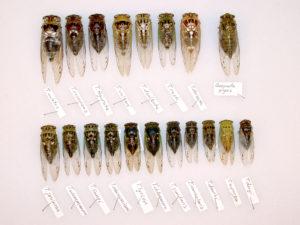Two relatively new cicada publications that should be worth reading:
1) Avian Predation Pressure as a Potential Driver of Periodical Cicada Cycle Length by Walter D. Koenig and Andrew M. Liebhold, The American Naturalist. This is a newly electronically published paper about what drives the long, prime-numbered lifecycle of Magicicada periodical cicadas.
Abstract:
The extraordinarily long life cycles, synchronous emergences at 13- or 17-year intervals, and complex geographic distribution of periodical cicadas (Magicicada spp.) in eastern North America are a long-standing evolutionary enigma. Although a variety of factors, including satiation of aboveground predators and avoidance of interbrood hybridization, have been hypothesized to shape the evolution of this system, no empirical support for these mechanisms has previously been reported, beyond the observation that bird predation can extirpate small, experimentally mistimed emergences. Here we show that periodical cicada emergences appear to set populations of potential avian predators on numerical trajectories that result in significantly lower potential predation pressure during the subsequent emergence. This result provides new support for the importance of predators in shaping periodical cicada life history, offers an ecological rationale for why emergences are synchronized at the observed multiyear intervals, and may explain some of the developmental plasticity observed in these unique insects.
Order it from JSTOR.
2) The Cicadas (Hemiptera: Cicadoidea: Cicadidae) of N. America North of Mexico by Allen F. Sanborn and Maxine S. Heath. 227 pages.
A comprehensive review of the North Amerian cicada fauna that provides information on synonymies, type localities, and type material. There are 170 species and 21 subspecies found in continental N. America north of Mexico. The book has 211 figures with each species photographed in color.
Buy it from the Entomological Society of America website. I’ve already ordered mine.
I can’t wait for Sanborn’s book on Central and South America (hopefully, that will arrive within the next few years).
Update:
I’ve received Allen F. Sanborn and Maxine S. Heath’s book. It’s focus is on identifying all species of cicada fauna in North America, north of Mexico, as the title says. It also identifies species that were reported to exist in this location, but do not. The book provides maps and common attributes of each genus of cicada, and then for each species it provides photos of the holotype (and the location of the holotype), as well as a history of its taxonomy.
















